Physiological disorders in mango and their management
A number of eco-physiological disorders in the mango crop limit fruit production and quality. Black tip, soft nose, clustering (Jhumka), fruit drop, internal necrosis, fruit cracking, softening of fruits (jelly seed), and spongy tissue are the most serious issues that must be addressed. The main goal of this chapter is to explain the causes of these disorders and how to manage them.
Black tip
Black tip is a serious type of physiological disorder that causes significant economic loss to orchardists. Dashehari has the highest risk of the disorder, while Lucknow Safeda has the lowest. Fruits are affected at the marble stage, resulting in a distinctive yellowing of tissues at the distal end. The colour intensities gradually fade into brown and, finally, black. The development of the fruits is slowed at this age, and the black spot at the tip gradually extends towards the upper part of the fruits. Such fruits ripen prematurely and yield very low returns. The black tip has a greater impact on orchards located near brick kilns. The fumes from the brick kilns are the culprits. It was discovered that there was an inverse relationship between the incidence and the distance of the orchard from the brick kiln. Spraying borax or washing soda on the marble stage of fruits was found to be effective in controlling the disease. Because borax undergoes alkaline hydrolysis in water, it could act as a buffering agent against the acidic constituents of brick kiln fumes. other alkaline compounds, such as caustic soda and washing soda, have also been found to be beneficial.
Internal necrosis
Internal necrosis is also a serious problem of mango fruits. During the initial stages of internal necrosis, water soaked brownish areas on the fruits are developed which gradually coalesce to form dark brown patches on the internal surface. The lower part of the affected fruits turns brown, sometimes black with corky and leathery skin. These fruits are normally not retained for longer period and drop off before attaining the physiological maturity. The disorder can be corrected by soil or foliar application of boron. For soil application, boron @ 250 g per tree should be incorporated at the time of october fertilization. Foliar spray of 1% borax is recommended to be given when fruit attain pea size followed by two more sprays at 10-15 days intervals which could minimise the disorder.
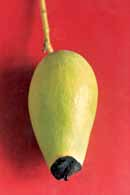

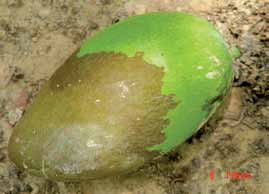
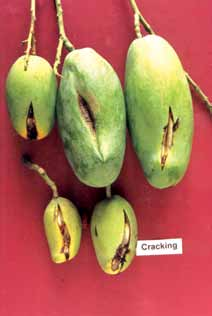
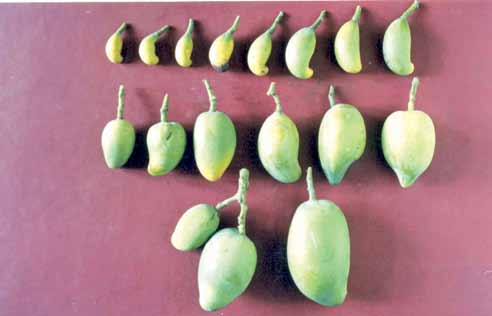
Fruit cracking
Mango fruit cracking is causing significant loss. Cracked fruits deteriorate quickly and frequently suffer secondary infestation by disease and pest, and the fruits eventually become unmarketable, causing significant financial loss to the grower. Pre-harvest sprays of NAA, potassium and boron and maintaining adequate soil moisture during the dry period were found to be beneficial in reducing cracking in fruit crops.
Fruit drop
In mango, in spite of profuse fruit set, the ultimate retention and harvestable produce is phenomenally very low primarily due to heavy fruit drop. The fruit drop is very high at the early stages of development but continues at a low rate till the fruits attain more than half size. The initial set varied from 23.5 fruits per panicle to 74.5 fruits, however, despite heavy initial number, fruit retention at harvest varied between 0.4 and 0.8 fruits per panicle. Besides many factors, the main factor for early drop is the low level of auxins and gibberellins and high level of ABA and ethylene. The extent of fruit drop can be reduced significantly by mulching and irrigation during fruit development, use of plant growth regulators NAA (20 ppm) timely and effective control measures against major pests and disease with proper nutrition.
Clustering or ‘Jhumka’
The disorder is characterized by the formation of a bunch of fruitlets of the size of marble at the tip of the panicle. The fruitlets are dark green in colour and their shape is much more curved than the normal shape of a developing fruit. This shape resembles that of unfertilized fruits which drop out very quickly after turning yellow. The dark green colour after attaining the size of marble, further growth ceases and thus remains in the panicle for a considerable period. The retention of these fruitlets for a longer period gives a general impression that there will be good set. However, these fruitlets do not grow further. Lack of pollination and fertilization owing to aberrant weather conditions, heavy spray of pesticides, which kills the pollinators resulted failure of pollination and fertilization of the fruit, which have been ascribed as the reasons for the occurrence of clustering.
Application of NAA (300 ppm) in the month of November on Dashehari reduced the clustered panicles. Lower concentrations of NAA (100-200 ppm) also reduced the clustered panicles.
Soft nose
A breakdown of the flesh on the ventral side and towards the apex in mango fruits, even when on the tree prior to harvest, has been termed ‘Soft Nose’. In Malaysia, the condition known as ‘Yeasty fruit rot’ or ‘Insidious fruit rot’ is probably identical with soft nose. Similar disorder was also noticed in Dashehari. Such physiological breakdown in Kent and Haden mangoes described as soft nose, has been engaging the attention of commerce and research workers. Investigation revealed that the disorder is of physiological nature but cure is not known.
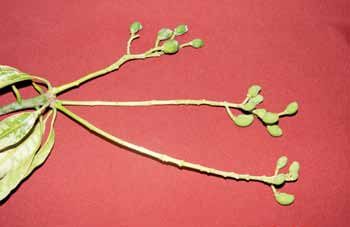
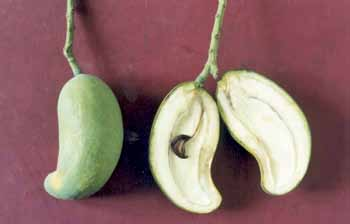

Jelly seed
Jelly seed is characterised by loosening of pulp tissues and jelly formation around the stone during the advance stage of maturity of the fruit. This malady renders the fruit unfit for consumption, reducing nutritional level and consumer acceptance which has become a bottleneck in export and expansion of mango industry. Small fruit and fruit harvested when ripe, as opposed to unripe but mature, appear more prone to breakdown. Nutrient imbalance, particularly the deficiency of calcium may be an important factor but evidence is lacking to enable any firm conclusion. In India it is restricted to cultivar Dashehari, however, cvs. Chausa and Amrapali were also
observed to develop jelly seed when they were harvested in late season. Sometimes fibrous type of mango like polyembryonic cultivar Turpentine has never exhibited such symptoms. As a method of control, preharvest spray of dihydrated calcium was found effective to reduce the occurrence of jelly seed formation.
Spongy tissue
Alphonso mango, which is the main export cultivar of India, suffers from a serious malady known as spongy tissue. In this disorder the external symptoms are not visible at harvesting, but when cut in half, the flesh is pale yellow in colour, soft or spongy with or without air cavity and has an off flavour. This disorder renders the fruit unfit for consumption and export to some extent. Earlier, this disorder was confined only in the cultivars grown at coastal region but recently the cultivar Mallika grown on dry track of subtropical region was also found affected with this disorder. Similar disorder was also noticed in Dashehari from Lucknow. In this cultivar the disorder invariably starts from the surface of the stone and maximum damage was noticed in the lower part as compared to middle and upper part. Convicting heat arising from soil and intense solar radiation are reported to be the main cause for this disorder. Different types of mulching were found effective for the control.
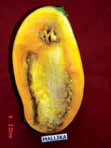
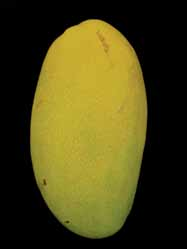
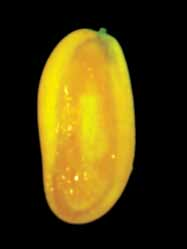

Author
V K Singh and S Rajan

